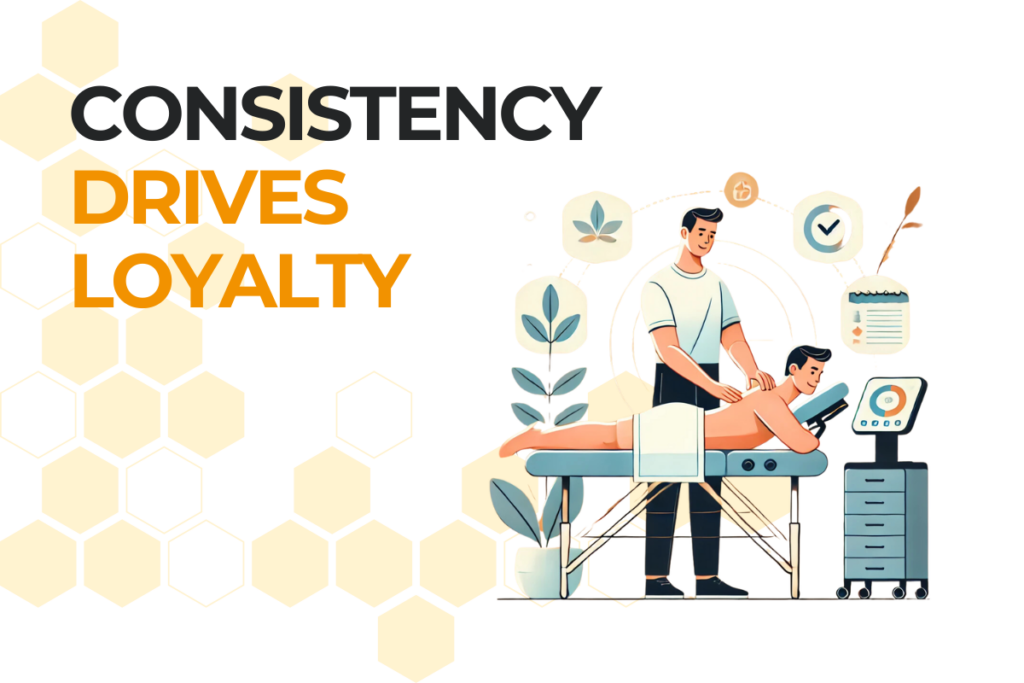Building Loyalty Through High Client Satisfaction
High client satisfaction in massage therapy is the foundation of a thriving clinic. When clients feel genuinely valued, respected, and cared for, they are not only more likely to return but also to spread the word about their positive experiences. Their recommendations and reviews are critical for attracting new clients and maintaining a solid reputation.
However, creating this level of satisfaction takes more than skillful hands—it requires tackling persistent challenges like ensuring consistent service, managing expectations, and fostering meaningful communication. This guide offers practical strategies to help you overcome these obstacles, providing the tools you need to create memorable client experiences and foster long-term loyalty.
The Secret to Consistent Client Experiences
Why Consistency Matters
Consistency is vital for achieving high client satisfaction in massage therapy. Inconsistent service can lead to mixed reviews and, ultimately, a loss of trust.
How to Standardize Quality Across Your Team
- Create Clear Protocols: Develop a detailed manual covering every aspect of the client experience, from the greeting to follow-up.
- Regular Training: Host ongoing education sessions to ensure therapists provide consistent, top-notch care.
- Feedback Loops: Use client surveys to uncover and address any inconsistencies promptly.
Real-Life Example: A Sherwood Park clinic adopted regular training programs, improving service consistency and boosting client retention by 20% in just one year.

Managing Client Expectations with Transparency
Why It’s Crucial
Unrealistic expectations can lead to disappointment. Clear communication is essential for aligning expectations and creating satisfaction.
Strategies to Align Expectations
- Transparent Consultations: Explain the scope, benefits, and realistic outcomes of each treatment.
- Educate Clients: Provide resources that outline therapy options and their potential results.
- Follow-Up Communication: Keep clients informed about their progress and adapt treatment plans as needed.
Pro Tip: Using tools like Hivemanager to automate appointment reminders and follow-ups can help keep clients informed and engaged.
Closing the Communication Gap
The Impact of Communication
Effective communication fosters trust and satisfaction. Clients who feel understood are far more likely to return.
Practical Communication Tips
- Active Listening: Encourage therapists to ask open-ended questions and truly listen to clients’ needs.
- Detailed Notes: Keep comprehensive records of client preferences and progress.
- Regular Check-Ins: Schedule follow-ups to ensure clients remain happy with their care.
Case Study: An Edmonton clinic introduced routine follow-ups after treatments, leading to a 35% increase in positive reviews and referrals within six months.
Handling Negative Feedback Constructively
Why Feedback Matters
Every piece of feedback is an opportunity to learn and improve. Addressing complaints effectively can turn unhappy clients into loyal advocates.
Steps to Address Complaints
- Acknowledge and Apologize: Show empathy and validate the client’s concerns.
- Offer Solutions: Provide thoughtful remedies such as discounted sessions or adjustments to treatment plans.
- Track Trends: Use recurring feedback to identify and address systemic issues.
Smart Tip: Hivemanager’s feedback tools make it easier to gather, analyze, and act on client input, ensuring continuous improvement.
Personalizing Client Care for Maximum Impact
Why Personalization Is Important
Tailored experiences make clients feel truly cared for, enhancing satisfaction and building loyalty.
How to Deliver Tailored Treatments
- Thorough Intake Forms: Gather detailed information about client needs and preferences during onboarding.
- Update Records: Keep meticulous notes to track client progress and adapt treatments accordingly.
- Flexible Plans: Be open to adjusting therapies based on real-time client feedback.
Real-Life Example: A North American clinic used digital records to personalize treatments, resulting in a 30% increase in client satisfaction scores.

Balancing Efficiency and Quality
The Challenge
Overloaded schedules can lead to rushed sessions, which negatively affect client satisfaction.
Solutions for Balance
- Optimize Schedules: Use appointment management tools to allocate sufficient time for each session.
- Staff Management: Hire and train enough therapists to handle demand without compromising quality.
- Set Boundaries: Ensure therapists have enough time to recharge and deliver their best work.
Building Long-Term Loyalty
Why Loyalty Matters
Loyal clients are the backbone of a successful clinic. They not only return regularly but also bring in new business through referrals.
Strategies to Foster Loyalty
- Loyalty Programs: Reward regular clients with discounts or special perks.
- Celebrate Milestones: Recognize anniversaries or personal achievements with thoughtful gestures.
- Stay Engaged: Use newsletters or social media to share wellness tips and stay connected with clients.
Moving Forward with Confidence
Creating high client satisfaction in massage therapy goes beyond providing a good massage. By prioritizing consistency, communication, and personalization, you can craft an experience that keeps clients coming back. These strategies will help you not only meet but exceed your clients’ expectations, setting the stage for lasting success and a thriving practice.
FAQs
Listen empathetically, acknowledge their concerns, and work together to find a resolution.
Platforms like Hivemanager can help streamline communication, collect feedback, and manage appointments efficiently.
Offer loyalty programs, personalized follow-ups, and incentives for booking additional sessions.
Regular training, ideally quarterly, helps ensure your team stays aligned with best practices and techniques.



